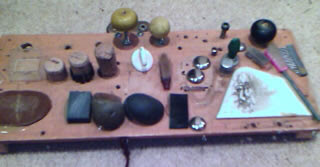This is a work in progress…
Instead of triads based on the 4:5:6 and the 7:9:11, these are based on 5:7:9, 7:12:16, and other fourth based triads.
This is a work in progress…
I’ve finally added crescendo and decrescendo ability to my macro preprocessor to Csound. Now, after I’ve generated the wave file, I run it through Csound again to modulate the overall amplitude. I can’t believe I relied on the volume of each note making the increase or decrease in loudness. How cumbersome it was! Every note had to be hand set to the desired volume, and the envelopes changed to implement an increase in sound.

This is a picture of the Dry Spring instrument. It is a 12″ piece of 1/4″ Sitka Spruce wood, with lots of things glued to the surface: tooth brush, rocks, comb, rubber strips, plastic, steel, cork, & glass. There is a contact microphone on the back side. For my latest piece, I recorded short samples of some of the sounds to use as percussion instruments, controlled by Csound.
This is a work in progress…
Today we hear from some new sections. Trills are handled by multiplying a note by a function table, like one shown on this page. The numbers represented by the graph are generated in csound with the following code:
f 421 0 256 -7 1 16 1 0 1.1249114 16 1.1249114 0 1 16 1 0 1.1249114 16 1.1249114
0 1 16 1 0 1.124911356 16 1.124911356 0 1 16 1 0 1.124911356 16 1.124911356
0 1 16 1 0 1.124911356 16 1.124911356 0 1 16 1 0 1.124911356 16 1.124911356
0 1 16 1 0 1.124911356 16 1.124911356 0 1 16 1 0 1.124911356 16 1.124911356 ; 9 : 8 120 up & down 9
I tell Csound what function table to multiply the note by, and then get a trill. In this piece, the C is tone 0, D a 9:8 above is tone 9, and E a 5:4 above C is tone 17. I multiply the C by the function number 421, and it trills from C to D. I create a triad with C, E, G, also known as 4:5:6 in just, and trill it to D, F+, A+, also known as 9:11:14. With a certain amount of randomness, it might play zero, one, two, or three notes at a time.
This is a work in progress…
One of the joys of 53 tone equal is that movements of a single step are so subtle as to be almost imperceptible. Each measure is in one key, then the next measure is up a step, then up another, and then back down in one step increments. Something sounds strange, but you can’t put your finger on it.